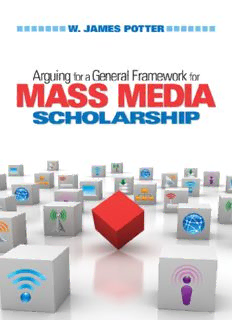
Arguing for a General Framework for Mass Media Scholarship PDF
Preview Arguing for a General Framework for Mass Media Scholarship
Arguing General Framework for a for Arguing General Framework for a for W. JAMES POTTER UniversityofCalifornia, SantaBarbara Copyright©2009bySAGEPublications,Inc. Allrightsreserved.Nopartofthisbookmaybereproducedorutilizedinanyformorbyany means,electronicormechanical,includingphotocopying,recording,orbyanyinformation storageandretrievalsystem,withoutpermissioninwritingfromthepublisher. Forinformation: SAGEPublications,Inc. SAGEPublicationsIndiaPvt.Ltd. 2455TellerRoad B1/I1MohanCooperative ThousandOaks,California91320 IndustrialArea E-mail:[email protected] MathuraRoad,NewDelhi110044 India SAGEPublicationsLtd. SAGEPublicationsAsia-PacificPte.Ltd. 1Oliver’sYard 33PekinStreet#02-01 55CityRoad FarEastSquare LondonEC1Y1SP Singapore048763 UnitedKingdom PrintedintheUnitedStatesofAmerica LibraryofCongressCataloging-in-PublicationData Potter,W.James Arguingforageneralframeworkformassmediascholarship/W.JamesPotter p.cm. Includesbibliographicalreferencesandindex. ISBN978-1-4129-6470-8(cloth) ISBN978-1-4129-6471-5(pbk.) 1. Massmedia—Research—History. 2. Massmedia—Research—Methodology. I. Title. P91.3.P6822009 302.23072—dc22 2008028743 Thisbookisprintedonacid-freepaper. 08 09 10 11 12 10 9 8 7 6 5 4 3 2 1 AcquisitionsEditor: ToddR.Armstrong EditorialAssistant: AjaBaker ProductionEditor: AstridVirding CopyEditor: GillianDickens Typesetter: C&MDigitals(P)Ltd. Proofreader: ScottOney Indexer: KathyPaparchontis CoverDesigner: CandiceHarman MarketingManager: CarmelSchrire Brief Contents Preface xiv PART I: INTRODUCTION Chapter 1: Why Do We Need a General Framework? 2 Chapter 2: Introduction to the General Framework 27 PART II: EXPLAINING THE MEDIA ORGANIZATIONS FACET Chapter 3: Mass Media Organizations Line of Thinking 46 Chapter 4: Business Strategies 59 Chapter 5: Marketing Strategies 72 Chapter 6: Employment Strategies 82 PART III: EXPLAINING THE MEDIA AUDIENCES FACET Chapter 7: Media Audience Line of Thinking 96 Chapter 8: Audience Cognitive Algorithms 115 Chapter 9: Audience: Filtering Media Messages 141 Chapter 10: Audience: Meaning Matching 161 Chapter 11: Audience: Meaning Construction 174 PART IV: EXPLAINING THE MEDIA MESSAGES FACET Chapter 12: Media Message Line of Thinking 190 Chapter 13: Message Formulas and Conventions—General 198 Chapter 14: Message Formulas and Conventions by Genre 208 Chapter 15: Critique of Media Message Scholarship 229 PART V: EXPLAINING THE MEDIA EFFECTS FACET Chapter 16: Media Effects Line of Thinking 242 Chapter 17: Conceptualizing Media Influence and Media Effects 260 Chapter 18: Designing Media Effects Studies 290 PART VI: CONCLUSION Chapter 19: Integration of Explanations 316 References 326 Author Index 367 Subject Index 379 About the Author 394 Detailed Contents Preface xiv PART I: INTRODUCTION Chapter 1: Why Do We Need a General Framework? 2 Generating-Findings Perspective on the Mass Media Growth of Mass Media Research Inductive Process Debates Large, Fragmented Literature Critique of the Generating-Findings Perspective Mapping-Phenomenon Perspective on the Mass Media Shaping Findings Into Knowledge Getting Past Categorical Thinking Focusing on Depth Over Breadth Favoring Convergence Over Divergence Focusing on the Big Picture Evolving Conclusion Chapter 2: Introduction to the General Framework 27 The Hub Problems in the Hub Developing the Hub The Spokes Problems With the Spokes Developing the Spokes The Rim Problems With the Rim Developing the Rim Conclusion PART II: EXPLAINING THE MEDIA ORGANIZATIONS FACET Chapter 3: Mass Media Organizations Line of Thinking 46 Definitions and Perspectives Fundamental Goals Value Goal Operating Goal Strategies Introducing the Business Strategy Introducing the Marketing Strategy Introducing the Employment Strategy Criticism of the Economic Goal Main Themes Analyzing the Criticism Conclusion Chapter 4: Business Strategies 59 Maximizing Resources Value Increasing Revenue Decreasing Expenses Reducing Risk Increasing Economic Power in the Marketplace Economies of Scope Consolidation Pyramid of Power Dynamic Nature Changing Structures Changes in Business Practices Conclusion Chapter 5: Marketing Strategies 72 Audience Delineation Identifying Existing Needs Niche Orientation Differential Value Crafting Messages Placing Messages in Environments to Attract Audiences Audience Conditioning Conclusion Chapter 6: Employment Strategies 82 Selection of Workers Skills and Talent Existing Values Demographics Socialization of Workers Structural Characteristics Professionalism Routines Media Logic Learning Values Learning Processes Shaping the News Formula Conclusion PART III: EXPLAINING THE MEDIA AUDIENCES FACET Chapter 7: Media Audience Line of Thinking 96 Conceptualizing the Audience Three Perspectives Big Questions Defining Exposure Media Exposure Research Exposure as Filtering Defining Attention Scholarly Literature Exposure States Importance of Considering Exposure States Information-Processing Tasks The Media Exposure Model Conclusion Chapter 8: Audience Cognitive Algorithms 115 Organization of the Human Mind General Structure Units Critique of Scholarship Processes of the Human Mind General Processes More Specific Processes Types of Learning Explicit Versus Implicit Distinction Active and Passive Learning Essential Nature of Automatic Processes Introducing the Construct of Algorithm Definition Essential Characteristics Origin of Algorithms Use of Algorithms The Set of Algorithms Conclusion
Description: